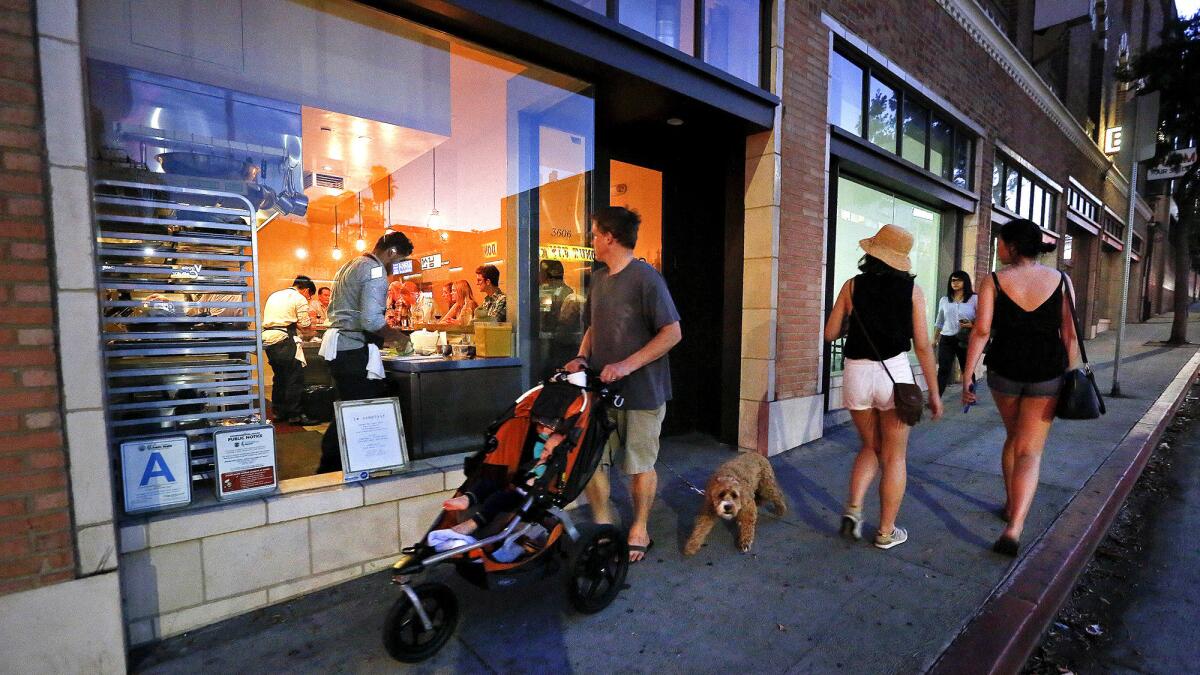In L.A., a walkable neighborhood comes at a price

Nobody walks in L.A., as the saying goes.
But many people want to and will pay more to live in more walkable neighborhoods where they can stroll to work, shops and restaurants from home. It’s a rare luxury in most metropolitan areas and one worth thousands of dollars on average, according to new research.
Home workers are willing to pay $3,260 — or nearly a percent more — for a little extra walkability than they would for the same home in a less pedestrian-friendly neighborhood, real estate website Redfin said in a study published this month.
When evaluating homes, the real estate brokerage issues so-called Walk Scores on a scale of 1 to 100 based on proximity — by foot — to local amenities. In most major housing markets, Redfin found that an incremental increase in walkability results in a substantial price premium for the property compared with another home in the same metro area.
Easy-to-walk neighborhoods are fairly rare — fewer than 2% of active listings have a Walk Score of 90 or higher, according to Redfin. In L.A., those neighborhoods include parts of Koreatown, Silver Lake and downtown.
More than half of millennials and 46% of baby boomers say they want pedestrian pathways where they live, according to Redfin.
Los Angeles, where homes sell for a median price of $475,000, has an overall Walk Score of 66.3. Each additional walkability point adds an average of $3,948, or a 0.83% bump, to the sale price.
“Just having that proximity is a really important thing,” said life coach Niyc Pidgeon, 29, who lives in pedestrian-friendly West Hollywood, on a street where the Walk Score is 88. “You have stronger social connections to things in your locality.”
Pidgeon doesn’t own a car and works from home. She says she currently operates in a “little 2-mile radius,” walking to her yoga and spinning classes and out to Starbucks or dinner.
“It’s nice to get out, rather than just going from house to car to house,” she said.
Score-wise, Los Angeles is “smack-dab in the middle” of the extremes of car-centric Orange County and pedestrian haven San Francisco, said Nela Richardson, Redfin’s chief economist. She noted that the city is embracing more multiuse commercial and residential complexes and park-like features.
“Los Angeles is in transition — an evolving city in terms of what is considered livable, and walkability is an important component of that,” she said.
Pedestrian access adds the most proportional value to homes in cities such as Atlanta, where the overall score is 48.4 and revitalization efforts are starting to open up more community gathering hubs. A single-point upgrade to an Atlanta home’s Walk Score boosts the sale price 1.69% on average.
But in places such as ritzy Orange County, walkability is far from a priority. Each point raises prices a mere 0.02% in the region, which has a 43.5 Walk Score.
Partly, this is because homes in the area tend to cost more than they would in Atlanta. But, especially in wealthy enclaves, foot traffic means more crowds and less seclusion.
In neighborhoods in the top 5% of Orange County’s price spectrum, slightly more walkability actually leads to a $451 price cut, compared with a $8,225 premium for the same demographic in Los Angeles.
“It’s not that luxury-home owners are couch potatoes,” Richardson said. “They just want exclusivity, the gated community with the view.”
The conclusion: Walkability tends to be more valuable in places that are already somewhat walkable. An increase from a score of 19 to 20 raises home prices by $181 on average, while a bump from 79 to 80 causes a $7,000 upswing.
And it helps to have a strong pedestrian culture — or at least the desire for one, according to Redfin.
“With the typical home, you need a certain amount of walkability already for the premium to really pay off,” Richardson said. “In cities with not a lot of infrastructure, it’s not going to have a lot of effect.”
Redfin based its research on sale prices and Walk Scores of more than 1 million homes sold across 14 major metropolitan areas between January 2014 and April 2016. Researchers controlled for differences in property size, number of bedrooms and bathrooms, building age, property type, neighborhood median income and other characteristics.
MORE HOT PROPERTY
Former vacation home of Brigitte Bardot is for sale in southeastern France
Home of the Day: Swing from the rafters in this artsy Venice Beach bungalow
Ellen DeGeneres quietly sells home in Hollywood Hills West for $9.9 million
More to Read
Sign up for Essential California
The most important California stories and recommendations in your inbox every morning.
You may occasionally receive promotional content from the Los Angeles Times.







